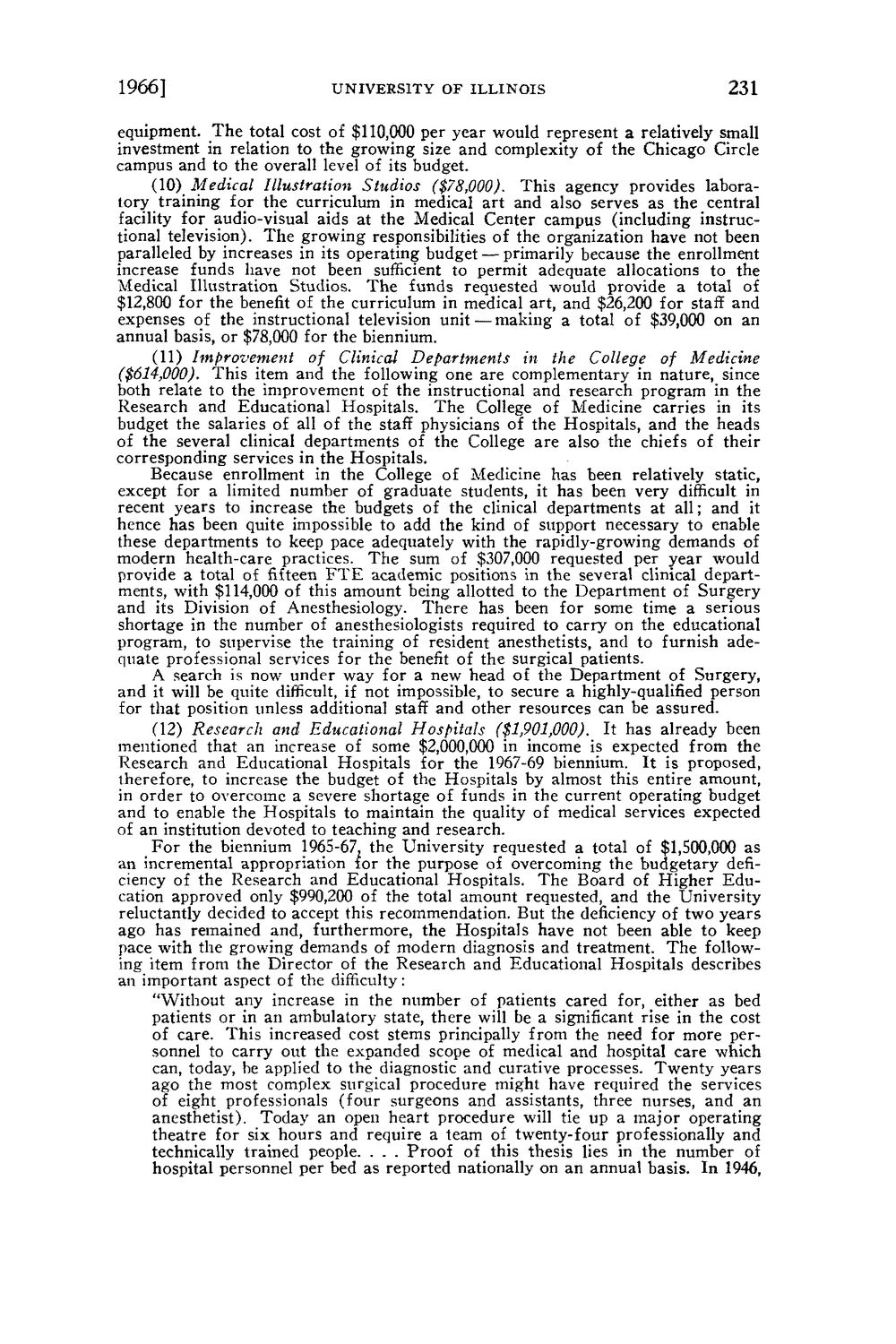| |
| |
Caption: Board of Trustees Minutes - 1968
This is a reduced-resolution page image for fast online browsing.

EXTRACTED TEXT FROM PAGE:
1966] U N I V E R S I T Y OF I L L I N O I S 231 equipment. T h e total cost of $110,000 per year would represent a relatively small investment in relation to the growing size and complexity of the Chicago Circle campus and to the overall level of its budget. (10) Medical Illustration Studios ($78,000). This agency provides laboratory training for the curriculum in medical art and also serves as the central facility for audio-visual aids at the Medical Center campus (including instructional television). The growing responsibilities of the organization have not been paralleled by increases in its operating budget — primarily because the enrollment increase funds have not been sufficient to permit adequate allocations to the Medical Illustration Studios. T h e funds requested would provide a total of $12,800 for the benefit of the curriculum in medical art, and $26,200 for staff and expenses of the instructional television unit — making a total of $39,000 on an annual basis, or $78,000 for the biennium. (11) Improvement of Clinical Departments in the College of Medicine ($614,000). This item and the following one are complementary in nature, since both relate to the improvement of the instructional and research program in the Research and Educational Hospitals. T h e College of Medicine carries in its budget the salaries of all of the staff physicians of the Hospitals, and the heads of the several clinical departments of the College are also the chiefs of their corresponding services in the Hospitals. Because enrollment in the College of Medicine has been relatively static, except for a limited number of graduate students, it has been very difficult in recent years to increase the budgets of the clinical departments at all; and it hence has been quite impossible to add the kind of support necessary to enable these departments to keep pace adequately with the rapidly-growing demands of modern health-care practices. The sum of $307,000 requested per year would provide a total of fifteen F T E academic positions in the several clinical departments, with $114,000 of this amount being allotted to the Department of Surgery and its Division of Anesthesiology. There has been for some time a serious shortage in the number of anesthesiologists required to carry on the educational program, to supervise the training of resident anesthetists, and to furnish adequate professional services for the benefit of the surgical patients. A search is now under way for a new head of the Department of Surgery, and it will be quite difficult, if not impossible, to secure a highly-qualified person for that position unless additional staff and other resources can be assured. (12) Research and Educational Hospitals ($1,901,000). It has already been mentioned that an increase of some $2,000,000 in income is expected from the Research and Educational Hospitals for the 1967-69 biennium. It is proposed, therefore, to increase the budget of the Hospitals by almost this entire amount, in order to overcome a severe shortage of funds in the current operating budget and to enable the Hospitals to maintain the quality of medical services expected of an institution devoted to teaching and research. For the biennium 1965-67. the University requested a total of $1,500,000 as an incremental appropriation for the purpose of overcoming the budgetary deficiency of the Research and Educational Hospitals. The Board of Higher Education approved only $990,200 of the total amount requested, and the University reluctantly decided to accept this recommendation. But the deficiency of two years ago has remained and, furthermore, the Hospitals have not been able to keep pace with the growing demands of modern diagnosis and treatment. The following item from the Director of the Research and Educational Hospitals describes an important aspect of the difficulty: "Without any increase in the number of patients cared for, either as bed patients or in an ambulatory state, there will be a significant rise in the cost of care. This increased cost stems principally from the need for more personnel to carry out the expanded scope of medical and hospital care which can, today, he applied to the diagnostic and curative processes. Twenty years ago the most complex surgical procedure might have required the services of eight professionals (four surgeons and assistants, three nurses, and an anesthetist). Today an open heart procedure will tie up a major operating theatre for six hours and require a team of twenty-four professionally and technically trained people. . . . Proof of this thesis lies in the number of hospital personnel per bed as reported nationally on an annual basis. In 1946,
| |